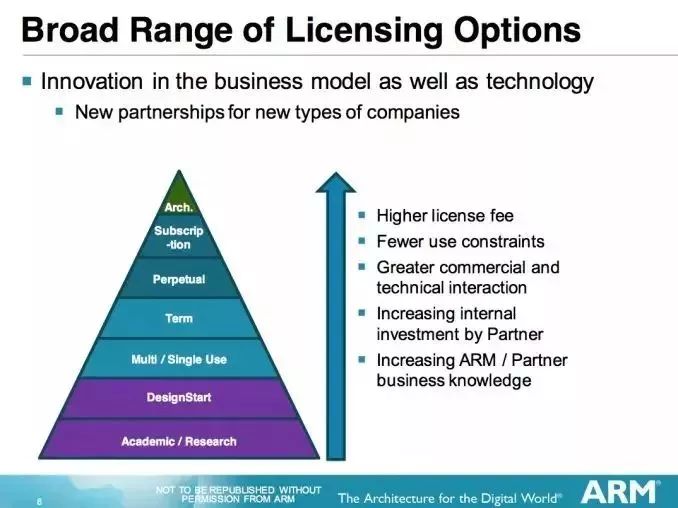Click on the above “Tencent Technology“, “star or pin the public account”
Key moments, delivered first


Source / Silicon Star (ID: guixingren123)
Author / Spectrum
Welcome to download the Tencent News APP to see more technology hot news
Huawei can rely on its existing ARMv8 license to hold on for a long time, enough to wait for this wave of technology embargo to end.
Today, Huawei’s technology embargo in the United States has escalated to a new global height.
According to the BBC, Arm, a UK technology company wholly owned by SoftBank, issued an internal letter to employees, requiring them to stop all contracts, technical support, and business dealings with Huawei and its subsidiaries.
As a chip giant in the mobile computing industry, Arm licenses its developed chip designs and instruction set architectures to well-known technology companies. Arm’s intellectual property is the underlying technology for Qualcomm Snapdragon, Apple A-series processors, and global 4G and future 5G base stations.
Huawei’s self-developed Kirin processors also use Arm’s instruction set architecture (ISA). This is because ARM and Intel’s x86 are the only two instruction set architectures supported by Android, which is the world’s most popular mobile operating system.
Given the unpopularity of x86, if Huawei wants to pre-install the Android operating system on its smartphones, it must use processors based on the ARM architecture, whether produced in-house or sourced from Qualcomm.
It seems that Huawei’s Kirin and smartphone business will suffer a huge blow. However, considering the complexity of the global technology licensing cooperation system and the mechanisms employed by Arm as the licensor, Huawei may be able to avoid difficulties for a considerable period and endure this round of technology embargo.
Due to Arm’s licensing model, the company’s internal ban on Huawei cannot substantively affect Huawei’s ability to continue using the ARM architecture to produce processors.

Arm is a chip designer, not a manufacturer. Selling the rights to use Arm’s intellectual property to global technology companies is the company’s business model.
To meet the needs of different customers, Arm has designed a complex licensing model.
For example, universities and non-profit research institutions can obtain licenses from Arm for research purposes through two basic free models: “Academic Research” and “DesignStart”; for profit-making companies, multiple or one-time use licenses can be obtained to receive a specified number of licenses for a specified period; Arm has also introduced a subscription model to help companies save on large deposit costs.
At the top of the pyramid are the instruction set architecture licensing models used by Huawei and 15 other top global technology companies. In this model, Arm grants a large amount of knowledge related to the instruction set architecture to Huawei without strict usage restrictions. This allows companies like Huawei and Apple to customize processors according to their needs. Of course, this licensing model is also the most expensive.
According to industry insiders, the instruction set architecture licensing model is licensed according to the version of the instruction set architecture, and the effect is permanent.
The highest version of the instruction set architecture released by Arm is ARMv8, which was launched in 2011, focusing on 64-bit processing to reduce power consumption and support for over 4GB of memory. Huawei obtained the license in 2013 and has since produced multiple models of Kirin processors based on ARMv8.
Arm’s internal ban cannot affect Huawei’s ability to design and develop processors based on the already licensed ARMv8 instruction set architecture and install them in smartphones. Considering that the release date of ARMv9 is not yet determined, and that Qualcomm Snapdragon, Apple, and Huawei Kirin processor technologies are still continuously updated (even many ARMv7 processors are still in service), ARMv8 is far from being obsolete.
Theoretically, Huawei can continue to design and produce Kirin processors using the ARMv8 instruction set architecture until this round of technology embargo is lifted. This means that Arm’s ban will not have a substantial effect on Huawei at least in the short term.
On the other hand, the official release date of ARMv9 is expected to be between 2020 and 2021, and the time for Arm to sign contracts with licensees can be as short as six months or as long as two to three years. Therefore, Arm’s current termination of dialogue and cooperation with Huawei will inevitably delay the technological upgrades of Huawei’s processors, reducing the market competitiveness of Huawei’s future processor products and smartphones.
Recent Highlights
The fateful battle of two septuagenarians
Ren Zhengfei answers 42 questions from the media (full transcript)
Highlights of Ren Zhengfei’s dialogue with domestic media